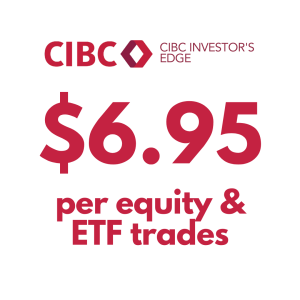
When you’re looking to invest your money, one of the first things you’ll need to decide is what type of account to use. After all, you can’t exactly invest your money in stocks, GICs, and more unless you have an account! There are a few different types of investment accounts available, and each has its own benefits and drawbacks. Here is a breakdown of the most common type of investment accounts in Canada.

Table of contents
What is an investment account?
An investment account is a type of financial tool that is designed to hold investments such as stocks, bonds, mutual funds and more. These accounts tend to provide a range of features and benefits to help investors manage and grow their assets over time. For example, many investment accounts offer the ability to seamlessly buy and sell securities online or through a smartphone app, with reasonable transaction fees.
Additionally, many investment accounts also allow users to set automatic contributions. An investment account also comes with security features to protect your money and personal information.
CIBC Investor’s Line Offer
Up to $6.95 per online stock or ETF trade. Plus, there’s no minimum account balance.
Registered vs non-registered investment accounts
There are two types of investment accounts in Canada: registered and non-registered.
A registered account is a specialized account that allows Canadians to save and invest their money in a tax efficient manner. Registered accounts are intended for long-term savings and investments, such as retirement funds or educational savings for children. You can invest in a variety of assets, including stocks, bonds and guaranteed investment certificates (GIC). These accounts are regulated by the Canadian government. They offer a variety of tax benefits, such as tax-sheltering or tax deferral on investment income.
There are several different types of registered investment accounts in Canada, including (but not limited to):
- Registered Retirement Savings Plan (RRSP)
- Tax-Free Savings Account (TFSA)
- Registered Education Savings Plan (RESP)
- Registered Disability Savings Plan (RDSP)
In order to open a registered account, an individual must first meet certain eligibility requirements. For example, they must be a Canadian citizen or permanent resident aged 18 or older. For more specialized accounts, there may be additional eligibility criteria to satisfy before you can open an account. Registered accounts also have various rules that govern things like maximum contributions and withdrawal restrictions. If you fail to meet these rules, you can run into fines.
A non-registered investment account is used for saving and investing in financial assets such as stocks, bonds, mutual funds, and derivatives. This type of account is not regulated by the government. Or any other official financial institution (aside from hosting the platform). This means there are no restrictions on the types of investments you can purchase, withdrawals or contributions. Often, non-registered accounts are used when registered accounts have been optimized. Alternatively, full-time investors or day traders may utilize a non-registered account for the bulk of their activity.
Types of investment accounts in Canada
Choosing the right type of investment account is just as important as selecting the right investments to meet your financial goals. So what are the different investment accounts in Canada? Let’s take a closer look below.
General investment accounts
These types of investment accounts are used for general savings and investing. This could be for anything from an emergency fund to a home renovation to a vacation fund.
Savings accounts
Savings accounts are one of the most popular types of investment accounts in Canada. These accounts allow individuals to store their money in a secure, safe place. While simultaneously earning a modest rate of interest on their balance. Unlike some other investment vehicles, savings accounts offer minimal risk and guaranteed returns. Additionally, these accounts tend to be very accessible, with many options for making deposits and withdrawing funds as needed.
Often, savings are not used for long term investing purposes. But having a savings account is an important part of financial health. They are used for emergency funds or storing money until you need it for something in the short term. For instance, a down payment or tuition payment. Many Canadians choose to put the funds into a GIC until they need it to maintain a certain degree of liquidity in their overall finances while earning some investment income.
Tax-Free Savings Account (TFSA)
A Tax-Free Savings Account, or TFSA, is a unique financial tool that can help individuals and families manage and save their money more effectively. A TFSA is a convenient way to save for short- and long-term goals, offering valuable tax benefits. The main benefit is tax sheltering on all investment income earned within a TFSA. In other words, if you receive a dividend or sell a stock for a profit in a TFSA, you won’t pay tax on the income.
Through regular contributions and smart investing, a TFSA can help you build your savings quickly and efficiently. Because the money you save in a TFSA grows tax-free, you won’t have to worry about losing anything to taxes. Finally, to withdraw from a TFSA is a relatively simple process if you ever need to use the funds.
Related Reading: TFSA Contribution Limit By Year to 2022
Unregistered Investment Accounts
An unregistered account, also called a “taxable” or “open” account, is an investment account where taxes are levied. Tax applies on any investment income earned. As mentioned above, these are not regulated by the Canadian government and are often used when registered accounts are optimized. You can use an unregistered account as part of your overall financial plan. With advantages like adaptability and no contribution or withdrawal restrictions.
Retirement investment accounts
These accounts are designed for retirement savings exclusively. Naturally, retirement savings are a long term objective which is reflected in how these accounts operate.
Registered Retirement Savings Plan (RRSP)
A Registered Retirement Savings Plan (RRSP) is a financial tool that allows you to keep money in a tax-deferred account for future use, specifically retirement. By contributing to an RRSP, you may reduce your taxable income now by the amount you contribute. This is better known as the RRSP tax deduction. The Canadian government created the RRSP to help Canadians save for retirement, as people are living longer and longer. Your RRSP’s contribution limit is based on 18% of your income from the previous year. With a defined maximum amount that increases along with the average wage each year. Many types of investments, like stocks, bonds, ETFs, and mutual funds can be put into an RRSP.
Related Reading: How to Withdraw Money from RRSP
Registered Retirement Income Fund (RRIF)
An RRIF is an arrangement between you and a carrier where the latter registers the former. You transfer property to your RRIF carrier from an RRSP, a PRPP, an RPP, an SPP, or other eligible account to make payments to you. The government requires that the minimum amount be paid to you annually. Earnings in an RRIF are not taxed, but distributions from the RRIF are taxable when received. In other words, a RRIF is a plan that enables you to collect steady income from your RRSP or other similar account.
Locked-in Retirement Account (LIRA)
A locked-in retirement account (LIRA) is a registered account. It was established to store and invest pension assets that you and your past employers paid into. The growth of investments inside the LIRA is tax deferred, which means you won’t have to pay taxes on gains until you take them out. For a LIRA, your assets are “locked in,” which means you can’t make any withdrawals until you reach a designated age (usually 55). The purpose of the “locked in” restrictions for a LIRA is to keep certain limitations that applied to the assets when they were under your employer’s pension plan. However, the actual “locked in” rules depend on provincial law.
Life Income Fund (LIF)
A life income fund (LIF) is a registered account that allows you to draw income from your locked-in pension assets during retirement. These funds can’t be taken out all at once, since the purpose of a LIF is to provide stable income throughout your life. If you’re a Canadian with a pension savings plan, you can transfer your pension into a locked-in income plan like a life income fund (LIF).
However, since the investments in a LIF are “locked-in,” you might not be able to withdraw money from them immediately. In some cases, such as Ontario and Nova Scotia, you may take out money from a LIF only at the age of 55, whereas in Alberta it’s 50. Other provinces, like Quebec, Manitoba, and New Brunswick allow you to withdraw funds from a LIF at any age. Some jurisdictions, like Saskatchewan, do not offer LIFs but do provide comparable locked-in products.
Related Reading: TFSA vs RRSP: Where to Put Your Money
Education investment accounts
Education is not cheap and often involves a certain level of commitment to save and pay for. The accounts below are designed for education savings.
Registered Education Savings Plan (RESP)
Registered Education Savings Plans (RESPs) are a way for parents, grandparents, family members or friends to save and invest for their children’s post-secondary education. Subscribers may establish an RESP account with a specific beneficiary by using the money deposited within one. The funds within an RESP grow tax-free, and the funds are taxed in the hands of the child when they withdraw it to pay for tuition and schooling costs.
General education savings
If you’re saving for your own education (or someone else’s in your family), as opposed to your child’s, you do not have the ability to use an RESP unfortunately. For this reason, you may use a savings account, TFSA or non-registered account to save and invest for education costs.
Alternatively, if you max out your child’s RESP contributions, you can continue to save for their education using another investment account.
Disability investment accounts
Canadians with a disability have additional costs of living to consider, including medical costs. For this reason, there are special accounts available for those living with a disability.
Registered Disability Savings Plan (RDSP)
A Registered Disability Savings Plan (RDSP) is a savings plan set up to assist parents and others in saving for the long-term financial security of someone who qualifies for the disability tax credit. You can make contributions to an RDSP until the end of the year when the beneficiary turns 59, and these contributions are not tax deductible. There are various other benefits of having an RDSP, including government contributions in the form of grants and bonds.
Invest in your future
Making wise financial decisions today is the key to securing a stable future. Whether you are just starting out in the working world or nearing retirement, investing in your future is one of the best ways to ensure that you are on track to meet your long-term goals. Some strategies for investing wisely include setting aside money regularly in a retirement or savings account, taking advantage of tax breaks and professional advice, and diversifying your portfolio. In addition, goal setting is important component to investing. Without a goal in sight, you’ll never move up in the world of finance!
No matter your current financial situation, it’s never too late to start investing in your future. There are a variety of investment accounts available that can fit any budget and timeline. If you’re not sure where to start, reach out to a financial advisor who can help you create a solid plan for long-term success. Good luck on your investing journey!
CIBC Investor’s Line Offer
Up to $6.95 per online stock or ETF trade. Plus, there’s no minimum account balance.
Read More: 4 Types of Income


